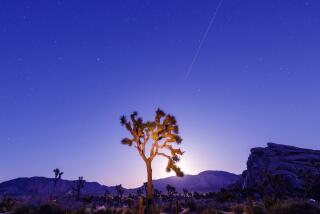NASA’s glamor shot of Saturn includes Earth, moon as tiny specks
NASA has released an amazing image of Saturn and its ghostly rings flanked by three of its fellow planets – Earth, Mars and Venus.
The picture, nearly four months in the making, was taken by NASA’s Cassini spacecraft when Saturn was backlighted by the sun. That made it possible for Cassini’s cameras to look toward the center of the solar system without damaging its cameras.
The portrait above is a mosaic of 141 wide-angle images taken by Cassini over a span of a little more than four hours. The images were taken from a distance of about 746,000 miles from the ringed planet, and the final picture spans a distance of nearly 405,000 miles across, according to NASA. Each pixel represents 45 miles of Saturnian terrain.
[Updated at 11:59 a.m. PST Nov. 13: Among the photo’s many admirers is Bobak Ferdowsi, the Jet Propulsion Laboratory engineer known to the world as “Mohawk Guy.” Cassini’s glamor shot prompted Ferdowsi to pay Saturn a compliment via Twitter:
You win this round of Hot or Not, Saturn. High res: https://t.co/wkNWAVefuC via @CassiniSaturn pic.twitter.com/6F5kOMErFE— Bobak Ferdowsi (@tweetsoutloud) November 12, 2013
The photo also spanned five columns on the front page of Wednesday’s New York Times.]
The picture combines images taken with Cassini’s red, green and blue spectral filters; NASA describes the result as a “natural-color view.” But there are enhancements to make things easier to see. Earth, Mars and Venus are 8.5 times brighter than Saturn, as are the Saturnian moons Enceladus, Epimetheus and Pandora. Tethys, another moon, is four times brighter.
Saturn’s inner rings were plenty visible on their own, but NASA gave a digital boost to the faint outer rings. In the background, 809 stars were also brightened relative to Saturn.
Saturn: Views of rings, moons and more
This was only the third time that Earth has been photographed from beyond the asteroid belt. The first was in 1990, when Voyager 1 took a picture from beyond the orbit of Neptune, and the second was in 2006, when Cassini took a similar picture. However, this was the first time NASA gave earthlings the opportunity to smile for the camera by encouraging them to wave at Saturn on July 19, 2013.
Here’s a brief rundown of what you can see in the pictures above (click through the photo gallery to find versions with planets and moons labeled):
Earth is in the lower right portion of the mosaic, situated between Saturn’s bright E ring and its faint G ring. If you look closely, NASA promises, you can see the moon peeking out from behind the pale blue Earth, on its lower right side. (If you need some help, go directly to this high-resolution view.)
Venus and Mars are in the upper right part of the picture. Venus is bright white and, like Earth, is between the E and G rings. Mars is faint and red, and it’s along the outer edge of the E ring.
Enceladus, the moon that shoots geysers of water that eventually form the E ring, can be seen on the left side of the picture. A plume of icy particles is visible.
Moving along counter-clockwise, the moons of Tethys, Mimas, Prometheus, Pandora, Janus and Epimetheus come into view , though several appear as thin crescents. Some of these moons cast noticeable shadows on Saturn’s E ring, “like a telephone pole might cast a shadow through a fog,” NASA explains.
You can find a more detailed description of the picture on NASA’s Photojournal website.
If you appreciate the fact that Cassini can take Earth’s picture from nearly 900 million miles away, you like the things I write about. Follow me on Twitter and “like” Los Angeles Times Science & Health on Facebook.
ALSO:
Comet ISON, visible in binoculars, now with a double tail
Found: A never-before-seen asteroid with six comet-like tails
Chelyabinsk meteor: More asteroids likely to hit Earth, research says






